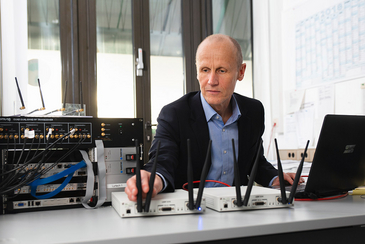The demands on a modern factory are increasing: not only are automation and reductions in cost required, but product diversity and reliability are too. Industry 4.0 intends to meet these needs, but it still lacks a decisive building block for a breakthrough: a wireless standard for reliable communication between machines in real time. A consortium led by the Center for Computing and Communication Technologies (TZI) at the University of Bremen has now developed the basis of such a standard as part of the “HiFlecs” project. The abbreviation “HiFlecs” stands for “Hochperformante, sichere Funktechnologien und deren Systemintegration in zukünftige industrielle Closed-Loop Automatisierungslösungen” (high-performance, safe wireless technologies and their system integration into future industrial closed-loop automation solutions).
The project is part of the German government’s high-tech strategy and was funded by the Federal Ministry of Education and Research (BMBF) with 4.76 million euros. In addition to the TZI, ten other partners from industry and science were involved in “HiFlecs.”
LTE Wireless Standard for Mobile Devices “Much Too Slow”
With conventional wireless technologies, the speed required in the future can hardly be achieved in automated manufacturing processes. “The delays in signal transmission for controlling production processes must be less than a millisecond,” explains “HiFlecs” project manager Professor Armin Dekorsy from the electrical engineering/communications engineering TZI working group. “For comparison: the current LTE wireless standard for mobile devices offers around ten milliseconds, which is far too slow.”
However, it is not only the speed that counts, but also the number of devices connected at the same time. In modern factories, thousands of sensors are often used to detect the position and condition of a product in the production line, for example. With the flood of data that this multitude of sensors generates at the same time, conventional wireless networks are overwhelmed.
In the “HiFlecs” project, the partners therefore pursued a holistic approach: they developed technologies for both fast data transfer and efficient network management. “HiFlecs” now helps to prioritize and distribute the information in a targeted way. “We had to design the networks very differently,” explains Dekorsy. “Coordinating machines with one another with less signaling must be possible in order to save bandwidth.”
Supplement to the 5G Wireless Standard for Mobile Devices
Dekorsy also sees “HiFlecs” as an opportunity to supplement the new fifth generation (5G) standard of mobile devices to meet the specific requirements of the industry. 5G also allows faster, more reliable communication, but is provided by network operators. With “HiFlecs,” companies can set up private networks so that they retain control over their data and possibly save costs.
The results of the project were prototypically implemented in a packaging machine of a globally active manufacturer. Until now, the machine required numerous cables to control its transport modules. “HiFlecs” allows switching to wireless, which reduces costs and weight. At the same time, installation is made easier. This is proof that the system works. Further development steps are now required before “HiFlecs” is ready for the market.
Additional Information:
www.ant.uni-bremen.de/de/projects/hiflecs/
www.uni-bremen.de
Contact:
Professor Armin Dekorsy'
University of Bremen
Center for Computing and Communication Technologies (TZI)
Phone: +49 421 218-62400
E-mail: dekorsyprotect me ?!ant.uni-bremenprotect me ?!.de

